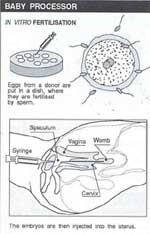The many faces of birthing
Artificial insemination by husband
When the husband's sperm count is low and moves sluggishly, agile sperm are selected from the husband's stock and placed in the wife's uterus.
Artificial insemination through donor
When the husband is infertile or suffers from a genetic disorder, sperm is obtained from a donor and placed in the woman's uterus.
In vitro fertilisation
Eggs and sperm from the couple involved or from donors are mixed in controlled conditions outside the body for 48 hours and then transferred to the uterus.
Both the donor and the recipient receive different hormonal treatments, the former to increase the number of eggs produced during her menstrual cycle, the latter to prepare her for pregnancy. The patient typically receives three to five embryos, in the hope that one will develop. But pregnancy takes more than one try; at the other end of the spectrum, it can end in multiple births.
Gamete intra-Fallopian transfer
Sometimes the sperm and eggs are merely mixed outside the woman's body and this mixture is injected into the Fallopian tubes -- which carry eggs to the uterus where fertilisation usually occurs -- where they fertilise naturally.
Zygote intra-Fallopian transfer
The sperm and eggs are mixed outside the body and are allowed to fertilise. After 24 hours, when a single-celled embryo, or zygote, is formed, it is transferred into the woman's Fallopian tubes


